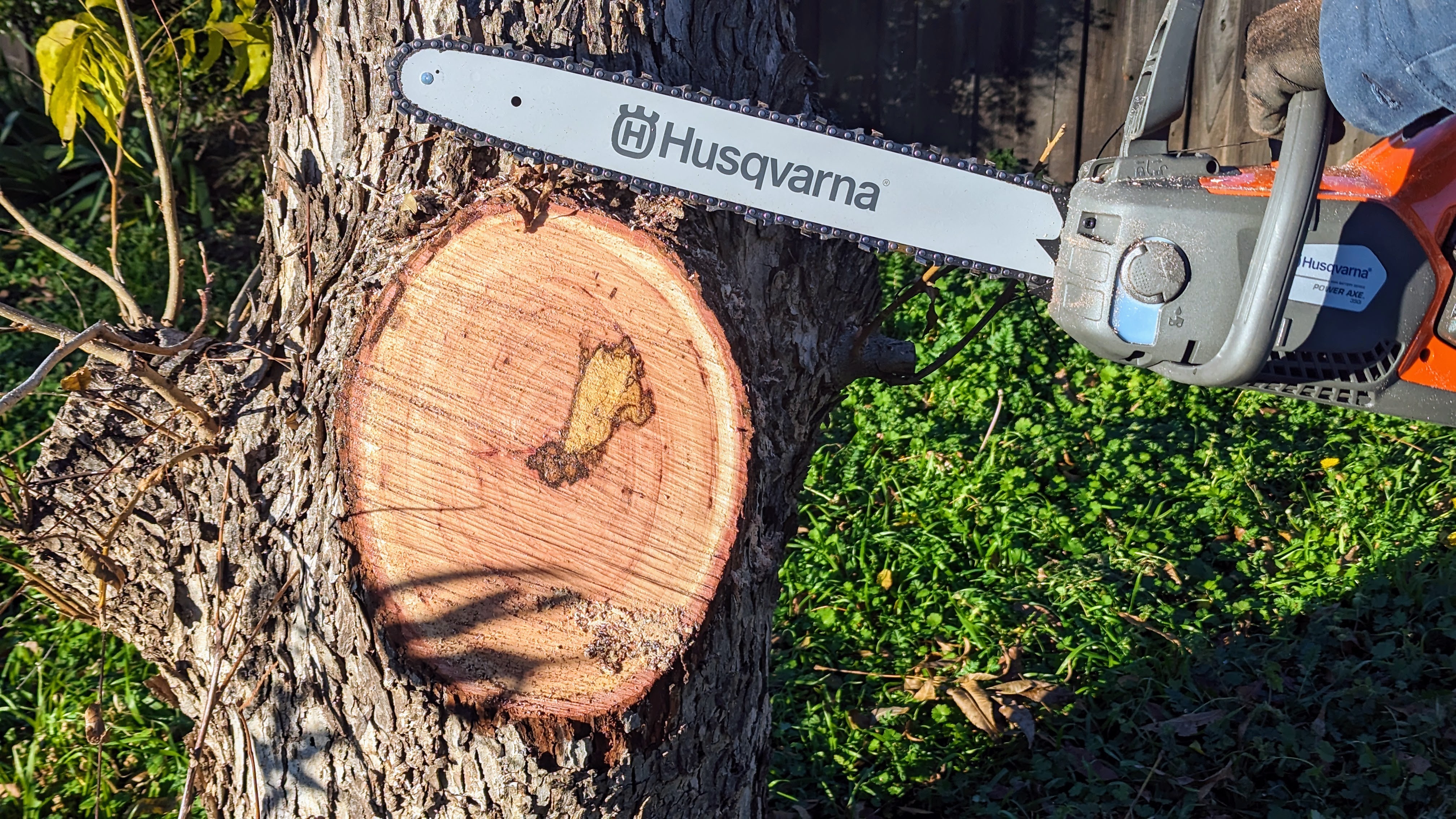- Chainsaw
- Work surface
- Combination spanner OR provided scrench (if tensioning manually)
- Work gloves (like this pair of HANDLANDY Work Gloves on Amazon from $9.80)
A chainsaw’s chain is crucial to its cutting performance. After repeated use (or incidents such as jamming), the chain may slacken, causing it to come off the bar during cutting. This can lead to damage or injuries, so keeping the chain properly tensioned is important.
While some of the best chainsaws have an easy-to-use, tool-free tensioning mechanism, others require a hand tool to tighten the chain. Either way, there are certain steps required to tension your chainsaw safely and successfully.
So, with help from a professional arborist and a representative of the chainsaw manufacturer Husqvarna, I will talk you through how to tighten your chainsaw’s chain. The process takes just a few minutes – so there’s no excuse for a slack chain!
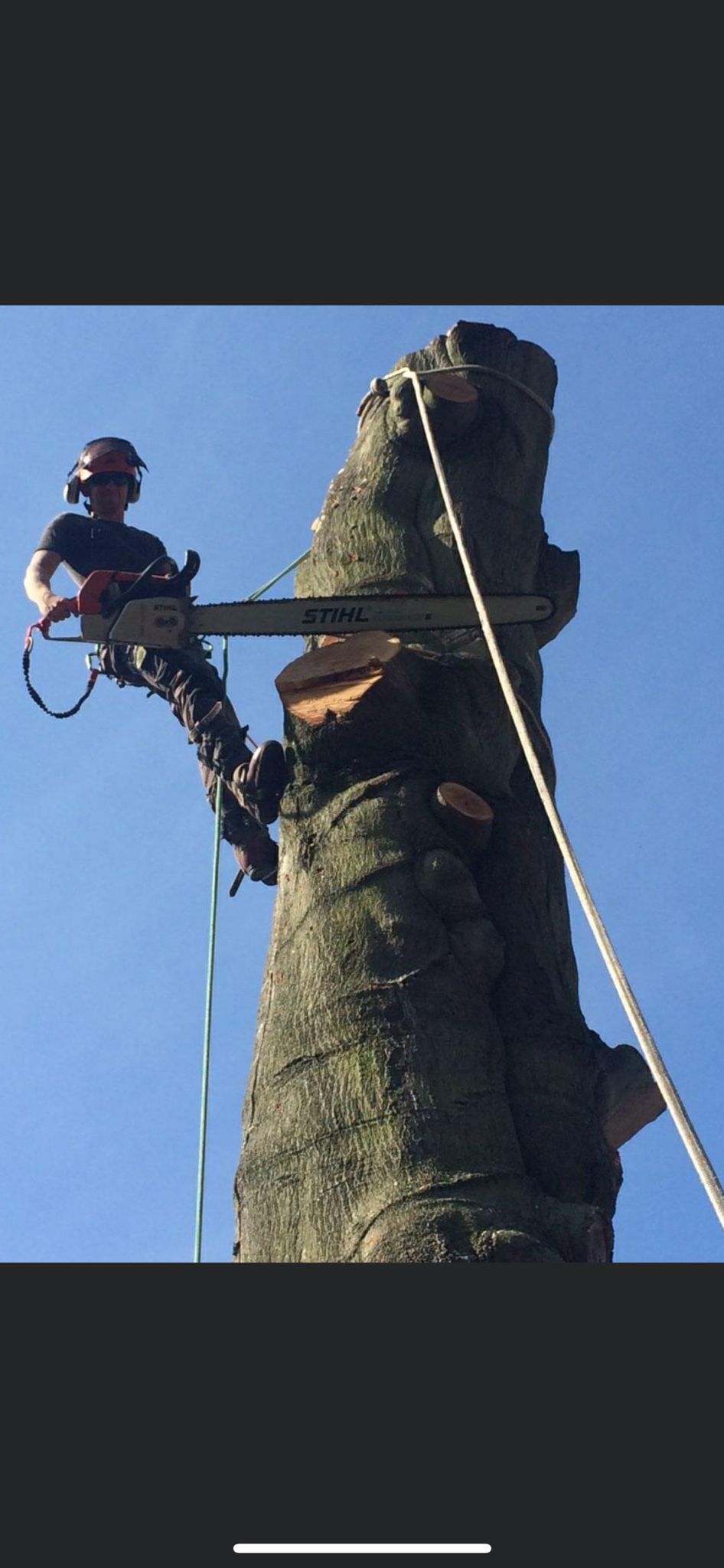
Arborist Joe Hardaker has amassed over a decade’s tree work experience in England, Jersey, New Zealand and Australia. He holds multiple academic qualifications in arboriculture (ND Arb, FdSc Arb, BSc Hort), and is Director and Proprietor of J H Arboriculture, which serves clients throughout Leeds, York and surrounding areas in the north of England.
Once you’ve mastered the process of chain tensioning, be sure to add it to your routine chainsaw maintenance checklist – it’s a task that should be done regularly, especially if your chainsaw blade has recently got stuck in some wood during cutting.
“It’s pretty important to have a correctly tensioned chain so that it doesn’t come off and potentially cause either injury or damage to your saw,” says Joe Hardaker, arborist and founder of J H Arboriculture.
“Just remember to wear gloves while tightening it,” he adds. This is a key point, as the bar and chain on your chainsaw will be sharp.
How to tighten a chainsaw chain: quick steps
- Identify the tension adjustment mechanism
- Prep the chainsaw for tensioning
- Adjust the tension
- Check the tension
How to tighten a chainsaw chain: Step by step guide
1. Identify the tension adjustment mechanism

First, you must identify the mechanism on your chainsaw that adjusts the chain tension.
“There are two types of chain tensioning mechanisms,” says Dan Vessell, Product Manager at Husqvarna.
“Chainsaws with ‘tool tensioning’ will require you to loosen the exposed guide bar nuts and adjust the tensioner with a scrench [or combination spanner].
“‘Tool-less tensioning’ chainsaws do not require the use of tools. The tensioner and the guide bar nuts are built into the chainsaw.”
If you’re unsure which type of tensioning mechanism your chainsaw has, consult the manufacturer’s instructions for guidance.

Dan Vessell is a Product Manager specializing in handheld products at the yard tool brand Husqvarna. With over 20 years’ experience in product development and marketing, Dan has a wealth of knowledge on tools – and how users can get the best out of them. Husqvarna is a world-leading maker of chainsaws, lawn mowers and other garden tools.
2. Prep the chainsaw for tensioning
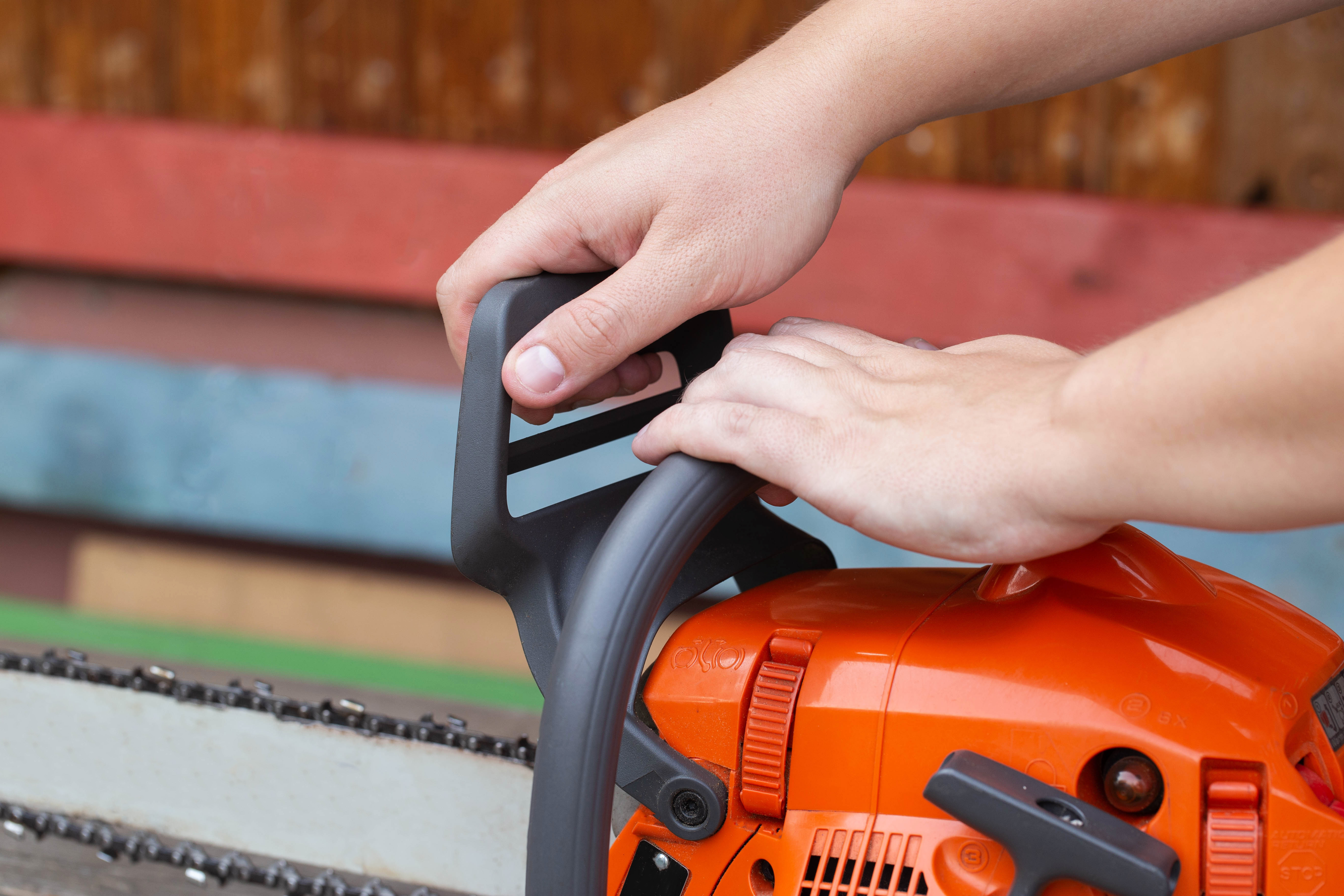
A chainsaw must be ready for tensioning by following a few steps. First, set the tool on a stable work surface and disengage the power source.
“Ensure the chainsaw's engine is not running and that it’s in the ‘Off’ position,” says Dan.
“If the chainsaw is battery-powered, remove the battery. If it’s corded, remove the plug from the outlet.”
Most chainsaws have a chain brake, a safety feature that can prevent the chain from moving.
You must release the chain brake before you start adjusting the chain tension—otherwise, you won’t be able to tighten (or loosen) the chain.
“Disengage the chain brake so the chain can move freely around the guide bar,” says Dan.
“Next, loosen the bar nuts on the clutch cover that hold the guide bar in place [if the chainsaw requires tool-tensioning].”
3. Adjust the tension
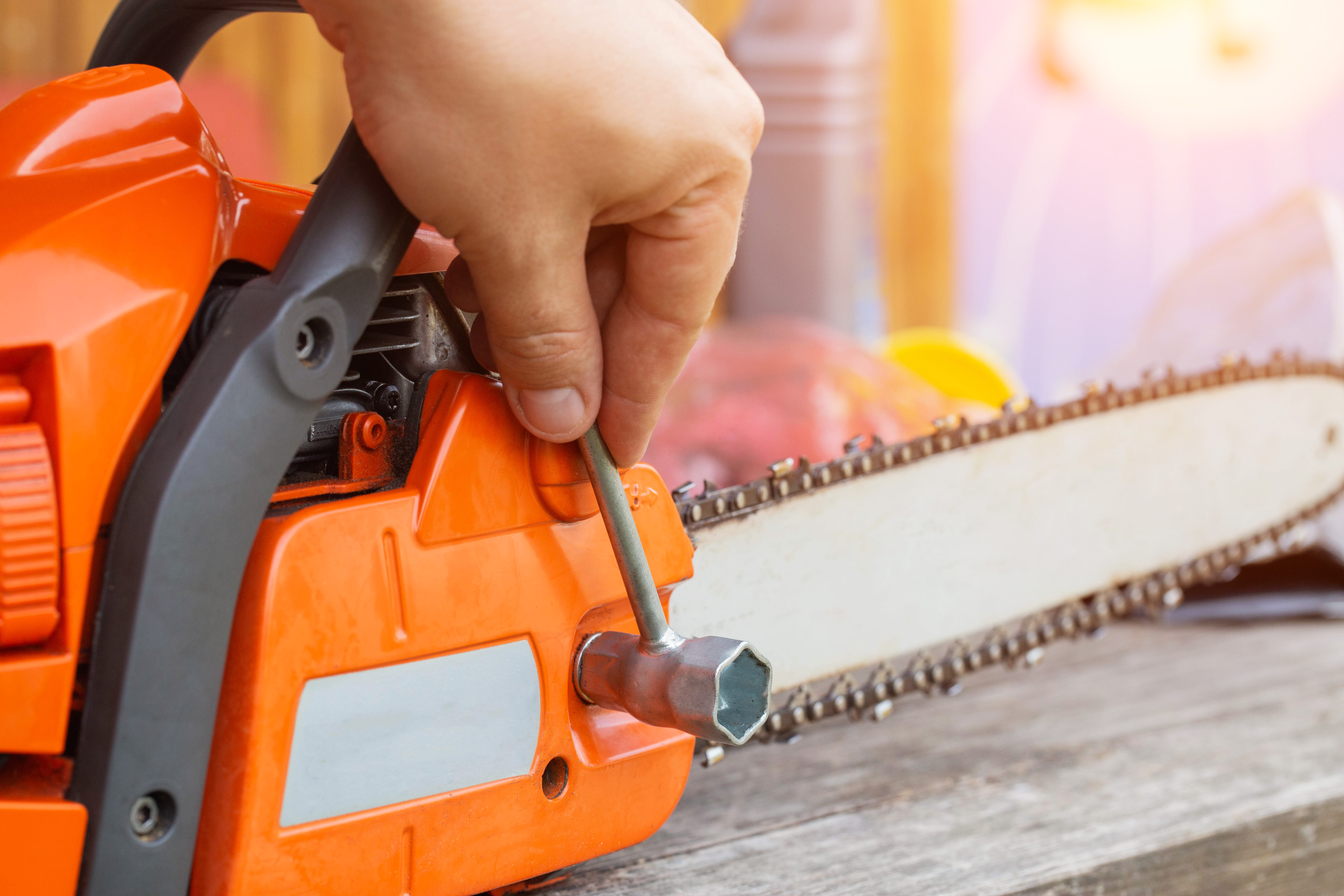
You’re now ready to go ahead and adjust the tension of your chainsaw’s chain.
“Turn the chain tensioner screw [or tool-free tensioner], and it will push a pin forward to tighten your bar,” says Joe.
“You need to lift the back of the saw so the nose is touching the bench until the bottom of the sagging chain touches the bottom of the bar, then give the screw another half turn,” he says.
4. Check the tension
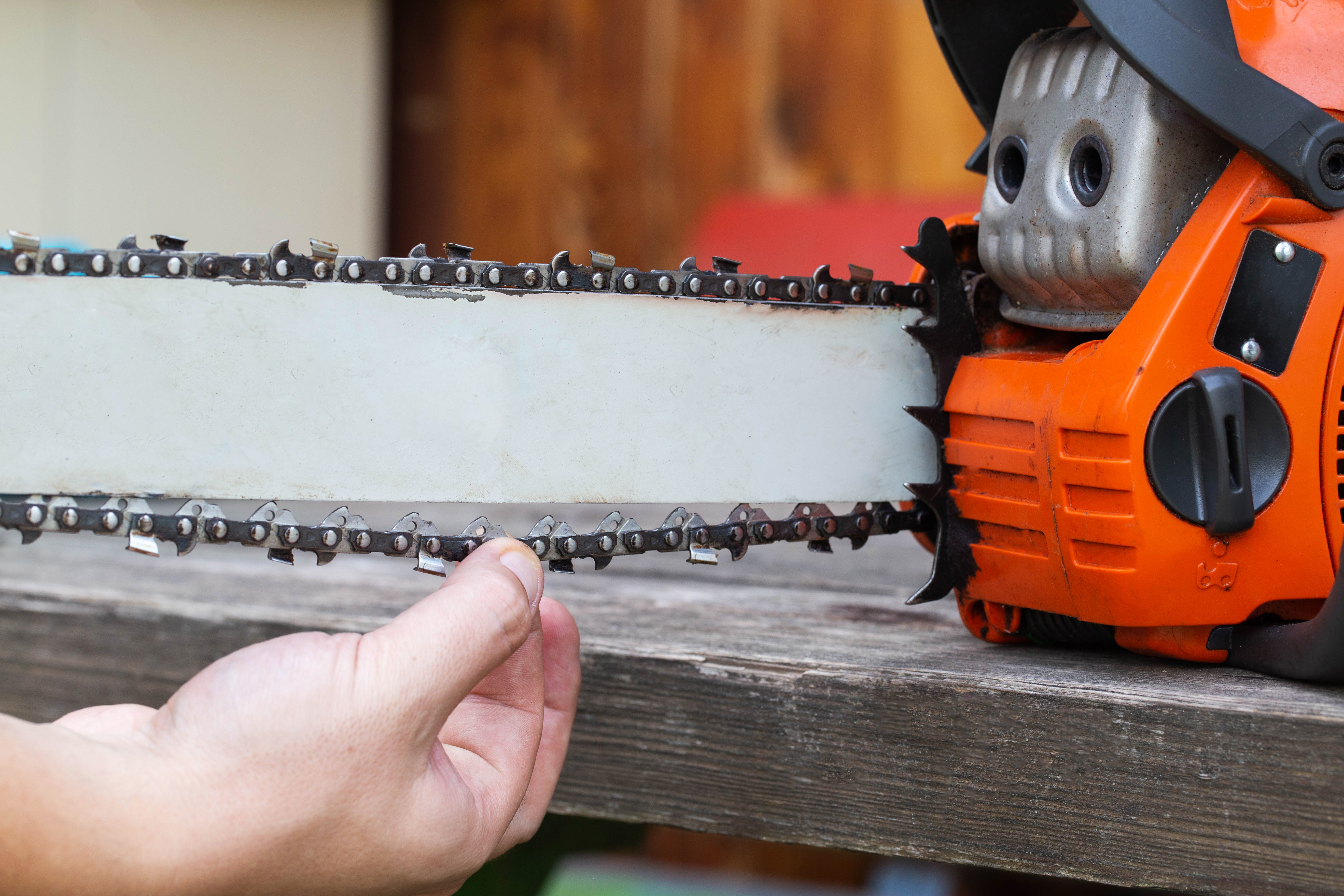
After tightening your chainsaw’s chain, check the tension to ensure you’ve tightened it enough (and not too much).
If your chain is properly tightened, the links will stay very securely engaged with the bar – but not so tightly that the chain cannot be pulled away slightly by (gloved) hand.
“Tighten the side cover nuts [or disengage the tool-free tensioner] and then test the tension by pushing the chain forward with your combo spanner,” says Joe.
“It should make a ‘croak’ sound if it’s tensioned correctly,” he adds.
“Ensure the chain rotates easily around the guide bar and tension is set correctly,” says Dan.
“If the chain is too tight and does not freely move around the guide bar, or there is too much slack in the chain, start back at Step #3.”
How to tighten a chainsaw chain: FAQs
Are some chainsaws easier to tension than others?
If you’re keen to choose a chainsaw with a simple and easy-to-tighten chain, look for a model with a tool-free tension adjustment feature.
“Consumer-grade or semi-professional chainsaws sometimes have a ‘Quick tensioner,’” says Joe.
“This is a circle-like flap that flips out of the tool. You can tension the chain by turning it, negating the need for a combo spanner.”
The steps involved in tightening a chainsaw chain using a tool-free tensioner are essentially the same as those required if using a tool, but the option to tighten the chain without needing to reach for a combination spanner or scrench might encourage you to complete this important maintenance task more regularly.
When does a chainsaw chain need replacing?
How often you need to replace your chainsaw’s chain will depend on several factors, including the quality of the chain, how much you use your chainsaw, and how diligently you perform maintenance tasks such as oiling and sharpening the chain.
A few bad usage practices can lead to premature breakage or damage to your chainsaw’s chain. These include allowing dirt and moisture to remain on the chain after use, leading to rust, over-tightening the chain, which may cause it to snap, and forgetting to keep it oiled.
Tightening the chain is one of several tasks required to maximize the performance and lifespan of your chainsaw.
Final thoughts
“The more you use a chainsaw, the longer the chain becomes, and a slack chain can jump off and cause serious or even fatal injury,” says Dan.
“It is therefore important to adjust the chain regularly to take up the slack. It is recommended to check the chain tension every time you refuel.
“Please note that a new saw chain has a running-in period during which you should check the tension more frequently,” he adds.
